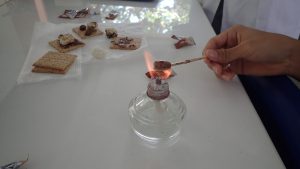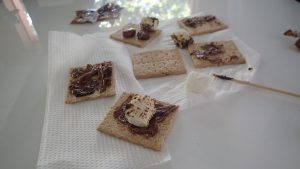FUN! FUN! Another day for Lab! FOOD!
You’ve ever cooked a meal from a recipe, you will have noticed they come with serving amounts, in fact, this number can be off, and you’ll end up with either less or more food than you anticipated. A number of things can take an account for this difference – food spillage prior to cooking, leaving ingredients too long on the stove top, using the wrong measuring cup, and so forth.
The similar can happen at whatever point we have an experiment in the chemistry lab to make a compound. We first make a calculation for how much of a compound we’ll end up with, in fact, these calculation are made under ideal conditions. They don’t account for experimental errors or personal errors of the experimenter. In the end, your prediction is often different from what you have actually made.
In Chemistry, we have learned about theoretical yield, which is the amount of the product calculated from the limiting reactant. The limiting reactant is the reactant in the chemical reaction that limits the amount of product that it can produce. The actual yield is the actual amount of the product, which the experiment produces.
The difference between theoretical yield and actual yield can be calculated by using percent yield, which we can use this formula:
In order to use this formula, the theoretical yield and actual yield need to have the same unit. If the actual yield in gram, the theoretical yield also need to be in gram. If the actual yield in mole, the theoretical yield also need to be in mole. If one has a different unit, we need to perform a conversion if we are giving one measurement in term of the unit.
We had conducted an experiment (S’more Lab). In order to make this S’more, we need substance, so teacher provide us Cracker, Chocolate, and Marshmallow.
| Substance | Symbol |
| Graham Cracker (half of a cracker) | Gc |
| Marshmallow | M |
| Chocolate Piece (individual piece of chocolate) | Cp |
| S’more (2 crackers, 3 pieces of chocolate, 1 marshmallow) | Gc2MCp3 |
We need to follow a certain step to create S’more
Step 1: Balance the equation
Cp + M + Gc → Gc2MCp3 to 3Cp + M +2Gc → Gc2MCp3
Step 2: Calculate the theoretical yield
In the experiment, I weight the substance. I got Graham Cracker (Gc) 8 grams, Marshmallow (M) 5 grams, Chocolate Pieces (Cp) 9 grams. I added all up, it has 30 grams of the substance
Step 3: Roast your marshmallows and chocolate on the Bunsen burner

Step 4: Putting the marshmallows and the chocolate between the cracker

Step 5: The ACTUAL (experimental) mass of one s’mores: 28.5 grams

Step 6: Calculate the percent yield
Experimental Yield = 28.5 grams
Theoretical Yield = 30 grams
% yield = (Actual yield / Theoretical yield) * 100
28.5/30 = 0.95 * 100 = 95%
Percent yield = 95%
Step 7: EAT YOUR S’MORE!!! (:

